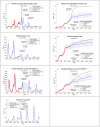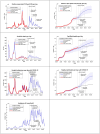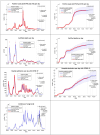Dynamic causal models in infectious disease epidemiology-an assessment of their predictive validity based on the COVID-19 epidemic in the UK 2020 to 2024
- PMID: 40385629
- PMCID: PMC12081349
- DOI: 10.3389/fpubh.2025.1573783
Dynamic causal models in infectious disease epidemiology-an assessment of their predictive validity based on the COVID-19 epidemic in the UK 2020 to 2024
Abstract
This technical report addresses the predictive validity of long-term epidemiological forecasting based upon dynamic causal modeling. It uses complementary prospective and retrospective analyses. The prospective analysis completes a series of (annual) reports comparing predictions with subsequent outcomes (i.e., cases, deaths, hospital admissions and Long COVID) reported a year later. Predictive validity is then addressed retrospectively by examining predictions at various points during the pandemic, in relation to actual outcomes at three, six and 12 months after the predictions were evaluated. This analysis suggests that-with a sufficiently expressive dynamic causal model-three, six and 12 month projections can be remarkably accurate (to within 10% or less of observed outcomes) at certain phases of the epidemic: namely, the initial phase-before the emergence of highly transmissible variants-and toward the end of the pandemic, when slow fluctuations in transmissibility and virulence can be estimated more precisely. However, the predictive accuracy in the intervening periods are compromised, to the extent that some forecasts only remain within their Bayesian credible intervals for 3 months. We provide a quantitative analysis of predictive accuracy for future reference and discuss the implications for epidemiological modeling, and forecasting, of this sort.
Keywords: compartmental models; coronavirus; dynamic causal modeling; epidemiology-descriptive; incidence; public health methodology.
Copyright © 2025 Bowie and Friston.
Conflict of interest statement
The authors declare that the research was conducted in the absence of any commercial or financial relationships that could be construed as a potential conflict of interest. The author(s) declared that they were an editorial board member of Frontiers, at the time of submission. This had no impact on the peer review process and the final decision.
Figures





Similar articles
-
A follow up report validating long term predictions of the COVID-19 epidemic in the UK using a dynamic causal model.Front Public Health. 2024 Sep 9;12:1398297. doi: 10.3389/fpubh.2024.1398297. eCollection 2024. Front Public Health. 2024. PMID: 39314791 Free PMC article.
-
Pandemic velocity: Forecasting COVID-19 in the US with a machine learning & Bayesian time series compartmental model.PLoS Comput Biol. 2021 Mar 29;17(3):e1008837. doi: 10.1371/journal.pcbi.1008837. eCollection 2021 Mar. PLoS Comput Biol. 2021. PMID: 33780443 Free PMC article.
-
Forecasting SARS-CoV-2 epidemic dynamic in Poland with the pDyn agent-based model.Epidemics. 2024 Dec;49:100801. doi: 10.1016/j.epidem.2024.100801. Epub 2024 Nov 12. Epidemics. 2024. PMID: 39550821
-
Investigating and forecasting infectious disease dynamics using epidemiological and molecular surveillance data.Phys Life Rev. 2024 Dec;51:294-327. doi: 10.1016/j.plrev.2024.10.011. Epub 2024 Oct 24. Phys Life Rev. 2024. PMID: 39488136 Review.
-
Usage of Compartmental Models in Predicting COVID-19 Outbreaks.AAPS J. 2022 Sep 2;24(5):98. doi: 10.1208/s12248-022-00743-9. AAPS J. 2022. PMID: 36056223 Free PMC article. Review.
References
-
- Friston K. (2021–2023). Long-term forecasting of the COVID-19 epidemic. Available online at: https://www.fil.ion.ucl.ac.uk/spm/covid-19/forecasting/ (Accessed December 4, 2024)
MeSH terms
LinkOut - more resources
Full Text Sources
Medical

